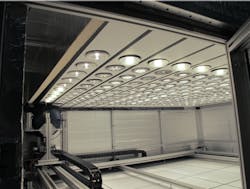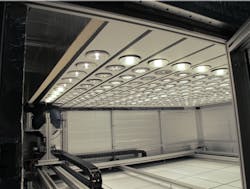In the ongoing Caliper 20 report series, the US Department of Energy has released a detailed comparison of LED PAR38 lamps, specifically focused on lumen and chromaticity maintenance over 14,000 hours of use.
The US Department of Energy (DOE) has released Caliper Report 20.4 — "Lumen and chromaticity maintenance of LED PAR38 lamps operated in steady-state conditions." The report compares LED PAR38 lamps performance along with legacy benchmark lamps over 14,000 hours of operation with ambient temperature maintained between 44°C and 45°C. Generally, the LED-based solid-state lighting (SSL) products outperformed the benchmark products, although there was significant variation in the different models of LED lamps tested.
The Caliper 20 series of reports has focused on the PAR38 category going back to the initial report in 2012 that covered photometric performance of new LED lamps, along with products based on legacy sources. Subsequently, the DOE published additional reports including Report 20.2 that focused on dimming and flicker in PAR38 lamps. And most recently, the agency published Report 20.3 focused on how well the LED PAR38 lamps stand up to stress conditions.
The new report considers 32 LED lamps, two compact fluorescent lamps (CFLs), three halogen lamps, and one ceramic metal-halide (CMH) lamp. The tests were performed by the DOE's Pacific Northwest National Laboratory (PNNL) in a custom-built "long-term test apparatus." The lab tested five samples of each of the 38 lamp models, recording lumen and chromaticity measurements weekly.
The testing did result in catastrophic failure of 13 LED PAR38 lamps, although those failures were from just five of the LED lamp models tested. Moreover, the DOE said five of the failures resulted from a system power failure and restart.
Not counting the catastrophic failures, the LED lamps delivered on average lumen maintenance of 95%. The halogen lamps all failed after falling to 80% of initial output. The CFLs averaged 68% lumen maintenance, and the one CMH product yielded 62% of initial output after 14,000 hours.
Still, the test revealed the broad range of performance and operational characteristics inherent in the myriad LED lamp designs. The average lumen maintenance was quite good but some products were exceptional, delivering greater than 100%, because in some cases LEDs become brighter early in their operational life. But two of the tested lamps had figures lower than 80%.
The LED PAR38 lamps also significantly outperformed the legacy products in chromaticity maintenance. PNNL chose to use the Δu'v' characteristics that are the basis of the CIE 1976 chromaticity diagram as the metric for comparison, noting that the color space afforded the most accurate and comparable measure of color shift. (Note: Stay tuned as we will have a feature article on chromaticity standards posted soon with our February issue content.)
In the test, the DOE said that only the CMH lamp performed particularly poorly with erratic changes over the course of the testing. Still, the LED lamps performed best on average, and the DOE noted that the legacy lamps would likely all have been replaced in an actual 14,000 hours of usage.
Two of the LED-based products had Δu'v' shifts greater than 0.007. That figure is important because Energy Star guidelines require lamps to achieve color maintenance below that level. The two LED lamps that exhibited the excessive shift also performed poorly in lumen maintenance, and the DOE concluded that the cause of poor color and lumen maintenance was likely linked.
The DOE did note that the continuous testing was not necessarily indicative of how lamps might perform in an actual deployment with temperature fluctuations and regular on-off cycles. The report also indicates that LED lamp performance can vary widely but is still generally superior to legacy products, and those benefits come on top of energy savings.







